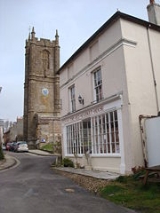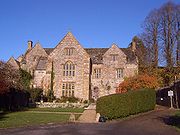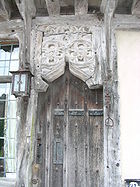
Cerne Abbas
Encyclopedia
Cerne Abbas is a village
located in the valley
of the River Cerne
, between steep chalk
downland
in central Dorset
, England
. The village is located just to the east of the A352 road 10 km (6.2 mi) north of Dorchester. There was a population of 732 at the 2001 census
, a figure which has fallen from 780 in 1998.
In 2008 it was voted Britain's "Most Desirable Village" by estate agent Savills. It is notable as the location of the Cerne Abbas Giant
, a chalk figure of a giant naked man on a hillside.
 The village of Cerne Abbas grew up around the great Benedictine
The village of Cerne Abbas grew up around the great Benedictine
abbey, Cerne Abbey
, which was founded there in AD 987. The Domesday survey
of 1087 recorded cultivated land for twenty ploughs, with 26 villeins and thirty two bordars. For more than 500 years, the abbey dominated the area. The abbey was surrendered to Henry VIII
in 1539 with the Dissolution of the Monasteries
and was largely destroyed; a portion of the Abbot's Porch and Abbey guesthouse remain. St Augustine's Well, reputedly blessed by the saint, also remains. St Mary's Church, built by the abbey for the parish in the late 13th century, is in the heart of the parish and retains many original features.
In the centuries after the Dissolution, the village thrived as a small market town
. Its wealth was partly generated by brewing, its underground water making it famous for the quality of its beer, which was sold as far away as London and was even exported to the Americas. At one time, Cerne Abbas had 14 public houses, serving visitors and a population of about 1,500. The availability of water power also gave rise to milling, tanning, silk weaving, glove and hat making and many other small industries.
The coming of the railways in the 19th century bypassed Cerne and the village went into decline. By 1906, the population had halved and many of the houses had fallen into disrepair. In 1919, the village was sold by the Pitt-Rivers
estate, which had owned it. The village now has a local school, a post office, three remaining historic public houses, tearooms and a number of other shops.
Pevsner says that Abbey Farm House which was rebuilt after a fire in the 1750s was formerly the main gateway to the abbey. When rebuilt, the central window of the former gateway projection was given an unusual Gothic Venetian window.
 Cerne Abbas is a tourist village with many attractions, including the river, streets lined with stone houses and the Abbey
Cerne Abbas is a tourist village with many attractions, including the river, streets lined with stone houses and the Abbey
. The church of St Mary is of 13th century origin but was largely rebuilt in the 15th and early 16th centuries and partly reconstructed in the 17th century. Features of interest include the 17th century pulpit and the great east window which probably came from the abbey.
, a 55 metre (180 ft) naked figure carved into the chalk hillside. The giant, owned by the National Trust
, is thought by many to be an Iron Age
fertility
symbol but, as it is unlikely that the monks of Cerne Abbey would have tolerated such a figure, and with no records before the 17th century, this cannot be confirmed. Many scholars now think that it was created in the mid-17th century, although there is evidence of Iron Age settlement on the downs nearby.
Village
A village is a clustered human settlement or community, larger than a hamlet with the population ranging from a few hundred to a few thousand , Though often located in rural areas, the term urban village is also applied to certain urban neighbourhoods, such as the West Village in Manhattan, New...
located in the valley
Valley
In geology, a valley or dale is a depression with predominant extent in one direction. A very deep river valley may be called a canyon or gorge.The terms U-shaped and V-shaped are descriptive terms of geography to characterize the form of valleys...
of the River Cerne
River Cerne
The River Cerne is a ten mile long river in Dorset, England, which rises in the Chalk hills of the Dorset Downs at Minterne Magna, flows down a valley through Cerne Abbas and Charminster, and flows into the River Frome in Dorchester....
, between steep chalk
Chalk
Chalk is a soft, white, porous sedimentary rock, a form of limestone composed of the mineral calcite. Calcite is calcium carbonate or CaCO3. It forms under reasonably deep marine conditions from the gradual accumulation of minute calcite plates shed from micro-organisms called coccolithophores....
downland
Downland
A downland is an area of open chalk hills. This term is especially used to describe the chalk countryside in southern England. Areas of downland are often referred to as Downs....
in central Dorset
Dorset
Dorset , is a county in South West England on the English Channel coast. The county town is Dorchester which is situated in the south. The Hampshire towns of Bournemouth and Christchurch joined the county with the reorganisation of local government in 1974...
, England
England
England is a country that is part of the United Kingdom. It shares land borders with Scotland to the north and Wales to the west; the Irish Sea is to the north west, the Celtic Sea to the south west, with the North Sea to the east and the English Channel to the south separating it from continental...
. The village is located just to the east of the A352 road 10 km (6.2 mi) north of Dorchester. There was a population of 732 at the 2001 census
Census
A census is the procedure of systematically acquiring and recording information about the members of a given population. It is a regularly occurring and official count of a particular population. The term is used mostly in connection with national population and housing censuses; other common...
, a figure which has fallen from 780 in 1998.
In 2008 it was voted Britain's "Most Desirable Village" by estate agent Savills. It is notable as the location of the Cerne Abbas Giant
Cerne Abbas giant
The Cerne Abbas Giant, also referred to as the Rude Man or the Rude Giant, is a hill figure of a giant naked man on a hillside near the village of Cerne Abbas, to the north of Dorchester, in Dorset, England. The high, wide figure is carved into the side of a steep hill, and is best viewed from...
, a chalk figure of a giant naked man on a hillside.
History

Benedictine
Benedictine refers to the spirituality and consecrated life in accordance with the Rule of St Benedict, written by Benedict of Nursia in the sixth century for the cenobitic communities he founded in central Italy. The most notable of these is Monte Cassino, the first monastery founded by Benedict...
abbey, Cerne Abbey
Cerne Abbey
Cerne Abbey was a Benedictine monastery founded in 987 AD in the town now called Cerne Abbas by Æthelmær the Stout. Ælfric of Eynsham, the most prolific writer in Old English was known to have spent time at the abbey as a priest and teacher....
, which was founded there in AD 987. The Domesday survey
Domesday Book
Domesday Book , now held at The National Archives, Kew, Richmond upon Thames in South West London, is the record of the great survey of much of England and parts of Wales completed in 1086...
of 1087 recorded cultivated land for twenty ploughs, with 26 villeins and thirty two bordars. For more than 500 years, the abbey dominated the area. The abbey was surrendered to Henry VIII
Henry VIII of England
Henry VIII was King of England from 21 April 1509 until his death. He was Lord, and later King, of Ireland, as well as continuing the nominal claim by the English monarchs to the Kingdom of France...
in 1539 with the Dissolution of the Monasteries
Dissolution of the Monasteries
The Dissolution of the Monasteries, sometimes referred to as the Suppression of the Monasteries, was the set of administrative and legal processes between 1536 and 1541 by which Henry VIII disbanded monasteries, priories, convents and friaries in England, Wales and Ireland; appropriated their...
and was largely destroyed; a portion of the Abbot's Porch and Abbey guesthouse remain. St Augustine's Well, reputedly blessed by the saint, also remains. St Mary's Church, built by the abbey for the parish in the late 13th century, is in the heart of the parish and retains many original features.
In the centuries after the Dissolution, the village thrived as a small market town
Market town
Market town or market right is a legal term, originating in the medieval period, for a European settlement that has the right to host markets, distinguishing it from a village and city...
. Its wealth was partly generated by brewing, its underground water making it famous for the quality of its beer, which was sold as far away as London and was even exported to the Americas. At one time, Cerne Abbas had 14 public houses, serving visitors and a population of about 1,500. The availability of water power also gave rise to milling, tanning, silk weaving, glove and hat making and many other small industries.
The coming of the railways in the 19th century bypassed Cerne and the village went into decline. By 1906, the population had halved and many of the houses had fallen into disrepair. In 1919, the village was sold by the Pitt-Rivers
Pitt-Rivers
-People:* William Horace Pitt-Rivers, 3rd Baron Rivers . Born William Beckford, he adopted the name on inheriting the title from his brother-in-law George Pitt, 2nd Baron Rivers.* George Pitt-Rivers, 4th Baron Rivers...
estate, which had owned it. The village now has a local school, a post office, three remaining historic public houses, tearooms and a number of other shops.
Pevsner says that Abbey Farm House which was rebuilt after a fire in the 1750s was formerly the main gateway to the abbey. When rebuilt, the central window of the former gateway projection was given an unusual Gothic Venetian window.
Tourist attractions

Cerne Abbey
Cerne Abbey was a Benedictine monastery founded in 987 AD in the town now called Cerne Abbas by Æthelmær the Stout. Ælfric of Eynsham, the most prolific writer in Old English was known to have spent time at the abbey as a priest and teacher....
. The church of St Mary is of 13th century origin but was largely rebuilt in the 15th and early 16th centuries and partly reconstructed in the 17th century. Features of interest include the 17th century pulpit and the great east window which probably came from the abbey.
Cerne Abbas Giant
The most famous attraction is the Cerne Abbas GiantCerne Abbas giant
The Cerne Abbas Giant, also referred to as the Rude Man or the Rude Giant, is a hill figure of a giant naked man on a hillside near the village of Cerne Abbas, to the north of Dorchester, in Dorset, England. The high, wide figure is carved into the side of a steep hill, and is best viewed from...
, a 55 metre (180 ft) naked figure carved into the chalk hillside. The giant, owned by the National Trust
National Trust for Places of Historic Interest or Natural Beauty
The National Trust for Places of Historic Interest or Natural Beauty, usually known as the National Trust, is a conservation organisation in England, Wales and Northern Ireland...
, is thought by many to be an Iron Age
Iron Age
The Iron Age is the archaeological period generally occurring after the Bronze Age, marked by the prevalent use of iron. The early period of the age is characterized by the widespread use of iron or steel. The adoption of such material coincided with other changes in society, including differing...
fertility
Fertility
Fertility is the natural capability of producing offsprings. As a measure, "fertility rate" is the number of children born per couple, person or population. Fertility differs from fecundity, which is defined as the potential for reproduction...
symbol but, as it is unlikely that the monks of Cerne Abbey would have tolerated such a figure, and with no records before the 17th century, this cannot be confirmed. Many scholars now think that it was created in the mid-17th century, although there is evidence of Iron Age settlement on the downs nearby.
Literature
- Cerne Abbas features in Thomas HardyThomas HardyThomas Hardy, OM was an English novelist and poet. While his works typically belong to the Naturalism movement, several poems display elements of the previous Romantic and Enlightenment periods of literature, such as his fascination with the supernatural.While he regarded himself primarily as a...
's WessexWessexThe Kingdom of Wessex or Kingdom of the West Saxons was an Anglo-Saxon kingdom of the West Saxons, in South West England, from the 6th century, until the emergence of a united English state in the 10th century, under the Wessex dynasty. It was to be an earldom after Canute the Great's conquest...
as "Abbots Cernel". - School of the Night, a mystery by Judith CookJudith CookJudith Cook was an anti-nuclear campaigner, historical novelist, journalist and lecturer in theatre at the University of Exeter...
set in Elizabethan England, contains scenes set in Cerne Abbas, and mentions the Cerne Abbas GiantCerne Abbas giantThe Cerne Abbas Giant, also referred to as the Rude Man or the Rude Giant, is a hill figure of a giant naked man on a hillside near the village of Cerne Abbas, to the north of Dorchester, in Dorset, England. The high, wide figure is carved into the side of a steep hill, and is best viewed from...
.

